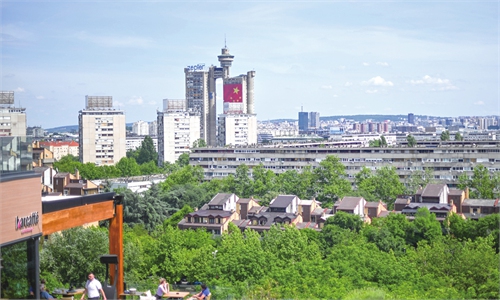
Blueberries are pictured at a blueberry garden in Wengbao Village of Majiang County, Southwest China's Guizhou Province, May 16, 2023. Photo: Xinhua
Serbia-produced blueberries that meet requirements will be allowed to be imported into China with immediate effect, China's General Administration of Customs (GAC) announced on Thursday.
The news comes as part of the achievements during the Chinese top leader's state visit to Serbia on Tuesday and Wednesday.
In a joint statement, the two countries announced a commitment to deepening and elevating the China-Serbia comprehensive strategic partnership. Serbia was the first Central and Eastern European country to become China's comprehensive strategic partner eight years ago.
As one of the milestones marking the partnership, China's National Development and Reform Commission (NDRC), the country's top economic planning agency, signed cooperation documents with Serbian government in areas including Belt and Road Initiative (BRI) cooperation, green development and the digital economy.
The NDRC signed a memorandum of understanding with Serbia's Ministry of Internal and Foreign Trade on a medium-term action plan for BRI cooperation, with the two sides agreeing to establish a working mechanism to implement the action plan, according to a statement on the NDRC website.
In addition, the NDRC and the Serbian Ministry of Environmental Protection agreed to carry out pragmatic cooperation in handling global climate change, environmental protection, the recycling economy, energy conservation and enhancing energy efficiency in a bid to boost the two countries' green transition.
The two countries also agreed to strengthen policy coordination on digitalization and expand partnership in fields including big data, information and telecommunication technology and cloud computing, and ramp up the digitalization of traditional industries, according to the NDRC.
These new achievements mark the extension of China-Serbia cooperation from traditional sectors such as steel to new industries, as well as an improvement in cooperation quality, Zhang Hong, a senior research fellow at the Institute of Russian, Eastern European and Central Asian Studies of the Chinese Academy of Social Sciences, told the Global Times on Thursday.
With this sound cooperation basis, Serbia has seen notable yields in the joint construction of the BRI, and it is expected to have a demonstration effect on cooperation between China and the region, Zhang said.
"More importantly, high-level exchanges between the two countries will inject greater confidence into the market and attract more enterprises to invest in Serbia," he said.
Serbia is China's first free trade partner in the Central and Eastern European region.
In 2023, China was the largest source of foreign direct investment for Serbia and the second-largest trade partner, official data showed. The two countries' cooperation in trade, industrial chains and infrastructure construction is on the rise, contributing to each other's modernization.
Standing at a new starting point, the joint construction of the BRI will boost bilateral economic and trade cooperation to a higher level and a larger scope, Wan Zhe, an economist and professor at the Belt and Road School of Beijing Normal University, told the Global Times on Thursday.
The free trade agreement between China and Serbia will take effect on July 1, the Xinhua News Agency reported.
Wan said that China has industrial and technological advantages in the green economy and should give play to the driving role of the Green Silk Road to increase infrastructure investment in Serbia to contribute to the Central and Eastern European country's green transition.
She said that the two sides should make cooperation in fields such as photovoltaic energy and new-energy vehicles a new growth point for bilateral economic and trade cooperation.



